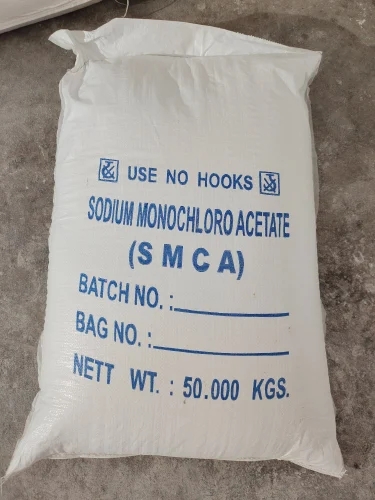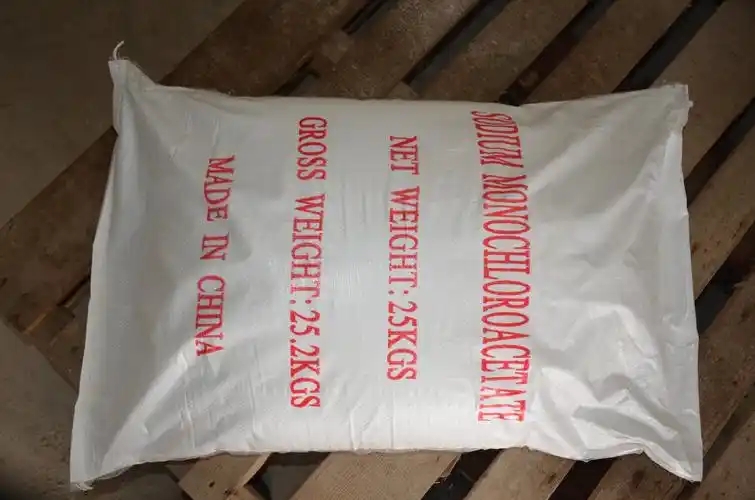📌 Detailed Introduction of Sodium Chloroacetate
✔ What is Sodium Chloroacetate?
Sodium Chloroacetate (SMCA) is the sodium salt of chloroacetic acid, a versatile chemical intermediate used in various industries, including agrochemicals, pharmaceuticals, dyes, and food additives. It is primarily used as a precursor in organic synthesis and plays a significant role in the production of Carboxymethyl Cellulose (CMC) and herbicides.
✔ CAS Number & Chemical Formula:
CAS Number: 3926-62-3
Chemical Formula: C₂H₂ClNaO₂
Molecular Weight: 116.48 g/mol
📌 Product Specifications
| Property | Specification |
|---|---|
| Appearance | White to off-white crystalline powder |
| Purity (%) | ≥ 98.0% |
| pH (1% solution) | 6.0 – 8.0 |
| Solubility | Soluble in water |
| Moisture Content (%) | ≤ 1.0% |
| Chloride Content (%) | ≤ 0.5% |
| Heavy Metals (ppm) | ≤ 10 ppm |
| Packing | 25kg fiber drums or customized packaging |
📌 Applications of Sodium Chloroacetate
✔ Agrochemical Industry
Used in the synthesis of herbicides such as 2,4-D (2,4-dichlorophenoxyacetic acid) and glyphosate.
Functions as a key raw material for plant protection products.
✔ Pharmaceutical Industry
Intermediate for the production of pharmaceuticals, including local anesthetics and muscle relaxants.
✔ Carboxymethyl Cellulose (CMC) Production
Sodium Chloroacetate is an essential raw material in the manufacturing of CMC, a widely used thickener, stabilizer, and emulsifier in food, pharmaceuticals, and cosmetics.
✔ Dyes & Textile Auxiliaries
Used in the synthesis of reactive dyes and other textile chemicals.
Functions as a modifying agent in textile processing.
✔ Other Industrial Applications
Used in the production of surfactants and synthetic resins.
Applied in water treatment chemicals as a chelating agent.
📌 How Does Sodium Chloroacetate Work?
Chemical Intermediate: Acts as a key building block in the synthesis of herbicides, pharmaceuticals, and industrial chemicals.
Carboxymethylation Agent: Reacts with cellulose and other organic compounds to introduce carboxymethyl groups.
Reactivity with Nucleophiles: Facilitates organic transformations in dye, textile, and resin industries.
📌 Production Method & Raw Materials
✔ Raw Materials Used:
Chloroacetic Acid
Sodium Hydroxide
✔ Production Process:
Neutralization: Chloroacetic acid is reacted with sodium hydroxide to form sodium chloroacetate.
Purification: The solution is filtered and refined to remove impurities.
Drying & Crystallization: The final product is crystallized and dried to achieve high purity.
Quality Testing & Packaging: The product undergoes strict quality control before packaging.
📌 Famous Sodium Chloroacetate Brands Worldwide
AkzoNobel (Netherlands)
Dow Chemical (USA)
Nouryon (Netherlands)
Jiangsu Khonor Chemicals Co., Limited (China)
📌 Why Choose Jiangsu Khonor Chemicals Co., Limited?
✔ High-Purity Sodium Chloroacetate (≥ 98.0%)
✔ ISO & GMP-Certified Production Facility
✔ Competitive Pricing & Global Export Services
✔ Custom Packaging & Bulk Supply Available
📌 Order High-Quality Sodium Chloroacetate from Jiangsu Khonor Chemicals Co., Limited!
Looking for a trusted Sodium Chloroacetate supplier? Jiangsu Khonor Chemicals Co., Limited provides bulk supply of premium-grade Sodium Chloroacetate for industrial, pharmaceutical, and agrochemical applications.
📞 Contact us today for a free quote & sample!
Product Name | Sodium Chloroacetate |
Synonyms | Sodium Monochloroacetate |
Appearance | White crystalline powder |
CAS No. | 3926-62-3 |
Molecular formula | C2H2ClNaO2 |
Molecular weight | 116.48 |
Content ≥% | 98.0 |
Dichloroacetic acid ≤% | 1 |
Sodium chloride ≤% | 1.5 |
Application | Alkylating agent, herbicide, dimethoate and benazoline production, reagent, medical synthesis, leather industry, metal surface treatment, pesticide intermediate, dying industry, pigment, |


